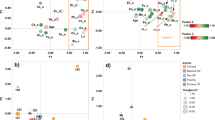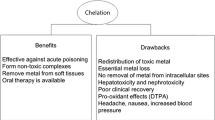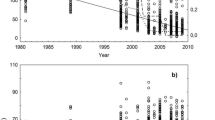Summary
Dependent on the level of occupational exposure to tetraethyl lead, the occurrence of early signs of toxicity and the urinary excretion of triethyl lead, diethyl lead and total lead compounds were investigated. This was done in the following cohorts in the province of Hubei, China: 277 workers at gasoline depots exposed to gasoline, 36 traffic policemen exposed to automobile ex haust and 342 public office workers (virtually non-exposed controls). Mean external tetraethyl lead exposure concentrations were 84.8 μg/m3 (as Pb) for the gasoline depot workers, 5.2 μg/m3 for traffic police and 1.1 μg/m3 for the controls. No significant subclin organic lead toxicity were found in the group of traffic policemen compared with the controls. In the cohort of gasoline workers, however, there was a statistical increase (vs controls) in the frequency of appearance of tremor and of sinus bradycardia. When the cohort of gasoline workers was divided into subgroups of different ranges of exposure, dose-dependence was noted. In general, the urinary excretion of triethyl lead was very low compared to that of diethyl lead, which appears to be a sensitive and specific indicator of exposure to tetraethyl lead; total lead excretion did not correlate well with actual external tetraethyl lead exposure. On the basis of these data it seems that current occupational exposure limits for tetraethyl lead are inadequate and need to be revised. In addition, a biological limit, based on urinary diethyl lead excretion, may be proposed.
Similar content being viewed by others
References
ACGIH (1986) Documentation of threshold limit values and biological exposure indices, 5th edn. ACGIH, Cincinnati, Ohio
Backes U, Bibernell U, Neidhart B (1989) Air sampling procedure for tetraalkyllead compounds. Fresenius Z Anal Chem 333:706
Beattie AD, Morre MR (1971) Tetraethyl-lead poisoning. Lancet I:12–15
Blaszkewicz M (1985) Entwicklung eines analytischen Verbundverfahrens zur quantitativen Bestimmung von Organobleiverbindungen im Spurenbereich. Doctoral dissertation, University of Wuppertal, Germany
Blaszkewicz M, Baumhoer G, Neidhart B (1984) Kopplung von HPLC und chemischem Reaktionsdetektor zur Trennung und Bestimmung von bleiorganischen Verbindungen. Fresenius Z Anal Chem 317:221–225
Blaszkewicz M, Baumhoer G, Neidhart B (1986) Bestimmung von Trialkylbleispezies in Urin. Fresenius Z Anal Chem 325:129–135
Blaszkewicz M, Baumhoer G, Neidhart B, Myslak Z, Rest T, Wandel E (1988) Untersuchungen zur berufsbedingten Belastung durch Tetraalkylblei: arbeitsmedizinische und analytische Aspekte. Verh Dt Ges Arbeitsmed 28:603–605
DFG (1972) Deutsche Forschungsgemeinschaft: Toxikologischarbeitsmedizinische Begründung von MAK-Werten. Verlag Chemie, Weinheim
DFG (1974) Deutsche Forschungsgemeinschaft: Bestimmung in Blut und Harn, Atomabsorptionsspektrometrie. Analysen in biologischem Material. VCH, Weinheim
Robinson TR, Rouge B (1974) Delta-aminolevulinic acid and lead in urine of lead antiknock workers. Arch Environ Health 28:133–136
Seeber A, Kiesswetter E, Neidhart B, Blaszkewicz M (1990) Neurobehavioral effects of a long-term exposure to tetraalkyllead. Neurotoxicol Teratol 12:653–655
Turlakiewicz Z, Chmielnicka J (1985) Diethyl lead as a specific indicator of occupational exposure to tetraethyl lead. Br J Ind Med 42:682–685
Yamamura Y, Takakura J, Hirayama F, Yamauchi H, Yohida M (1975) Tetraethyl lead poisoning caused by cleaning work in the aviation fuel tank. Jpn J Ind Health 17:223–235
Zhang W (1993) Untersuchungen zur berufsbedingten Belastung durch Tetraethylblei in der VR China (Wuhan). Doctoral dissertation. Heinrich Heine University of Düsseldorf, Germany
Zhang YD, Zheng L, Jiang L (1992) The hygienic study of occupational harm on the police. (in Chinese) J Occup Med (China) 36:7–15
Author information
Authors and Affiliations
Additional information
This paper summarizes data of a thesis (Zhang 1993) submitted to the Medical Faculty of the Heinrich-Heine-Universität Düsseldorf, in partial fulfilment of the requirements for the doctoral degree
Rights and permissions
About this article
Cite this article
Zhang, W., Zhang, GG., He, HZ. et al. Early health effects and biological monitoring in persons occupationally exposed to tetraethyl lead. Int Arch Occup Environ Health 65, 395–399 (1994). https://doi.org/10.1007/BF00383250
Received:
Accepted:
Issue Date:
DOI: https://doi.org/10.1007/BF00383250




